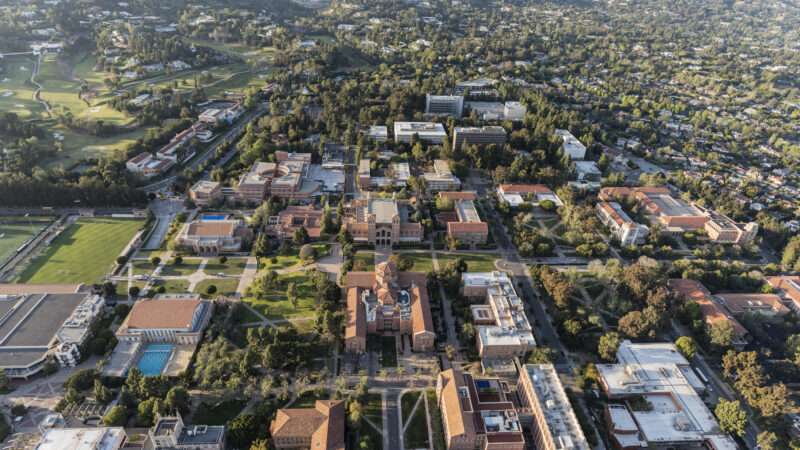
For many California college students, navigating homelessness or overcrowding has become part of getting the degree.
Five percent of University of California (U.C.) students and 10 percent of California State University (CSU) students are homeless during the academic year, according to one state estimate. The two public university systems have a combined 16,000-person waiting list for on-campus student housing.
Meanwhile, those in search of private, off-campus housing describe a punishing months-long grind of Craigslist searches and competing with 40 other applicants for the chance to rent a single room in a 50-year-old home.
"You'd regularly see the street lined with students sleeping in cars," says Nolan Gray, research director at California YIMBY and a PhD student at UCLA. "I had students in classes that I helped teach who were sleeping in cars, sleeping two to three people to a bedroom while still paying $1,000 a rent. "
This has prompted some policy makers to remove regulatory obstacles to building more on-campus student housing.
On Wednesday, Gov. Gavin Newson signed a new bill, S.B. 886, that exempts some on-campus student housing projects from the arduous environmental review process mandated by the California Environmental Quality Act (CEQA).
CEQA requires government agencies to study the environmental impacts of projects, both public and private, that they have discretion over. The law also allows third parties to appeal or even sue over the approval of said projects if they think an agency hasn't done enough to study its environmental impacts.
Anti-growth activists frequently use the law to stop new housing, including new student housing.
In one 2018 case, UCLA agreed to shrink a new dormitory project by three floors—that's 200 beds—to stave off complaints from neighbors. That didn't stop those residents from filing a CEQA suit targeting the diminished project.
Sometimes these lawsuits stop students as well as the student housing.
Earlier this year, some Berkeley townies convinced the California Supreme Court to freeze student enrollment at U.C.–Berkeley on the logic that admitting more students was a "project" whose environmental impacts required studying under CEQA.
That lawsuit attracted nationwide ire, confirming for many the view that California's NIMBYs were successfully choking off progress and opportunity in the state. The outrage proved enough that the California Legislature—usually loath to touch CEQA—quickly passed a bill undoing Berkeley's enrollment freeze.
Some legislators at the time argued that such a narrow fix was insufficient.
"The triage legislation we passed today will solve that immediate problem. But it's not enough just to solve this immediate problem; we need to ask ourselves how we got here," said S.B. 886's author, state Sen. Scott Wiener (D–San Francisco), in a statement issued in March. "When it comes to CEQA, this UC Berkeley trainwreck isn't a bug. It's a feature."
To prevent future trainwrecks, the bill Wiener authored exempts new university housing projects from CEQA, provided they adopt stringent energy and environmental design standards, aren't replacing existing housing, aren't in flood zones and historic districts, and contain fewer than 2,000 units or 4,000 beds. The university would also have to hold a public hearing on the project.
That doesn't make all dormitories bulletproof from CEQA lawsuits. It wouldn't save U.C.–Santa Barbara's infamous 4,500-bed cube dormitory. But the legislation still routes around the worst forms of CEQA obstructionism for obviously necessary and environmentally low-impact housing.
As Gray notes, it doesn't fix a more general problem of low-density zoning near major universities.
"If you look at almost every U.C. campus, in many cases they are hemmed in by single-family zoning," he tells Reason. "That's a policy that makes it illegal to build apartments, which is exactly the kind of housing stock that students need."
To the best of my knowledge, every UC campus has single family detached housing directly adjacent to it. I think those people should be forced by the state to welcome a whole lot of new neighbors! pic.twitter.com/EU4jeSv9Oq
— Stan Oklobdzija (@stan_okl) September 28, 2022
Earlier this year, the state did implement a new law that allows homeowners in single-family-zoned neighborhoods to divide their lots in two and build a duplex on each half. But local governments retain the ability to block larger apartment buildings and the single-room occupancy housing that students would typically rent.
California's housing crisis is a multifaceted thing. It requires multifaceted fixes.
The post California's Housing Crisis Hasn't Spared the State's College Students appeared first on Reason.com.






